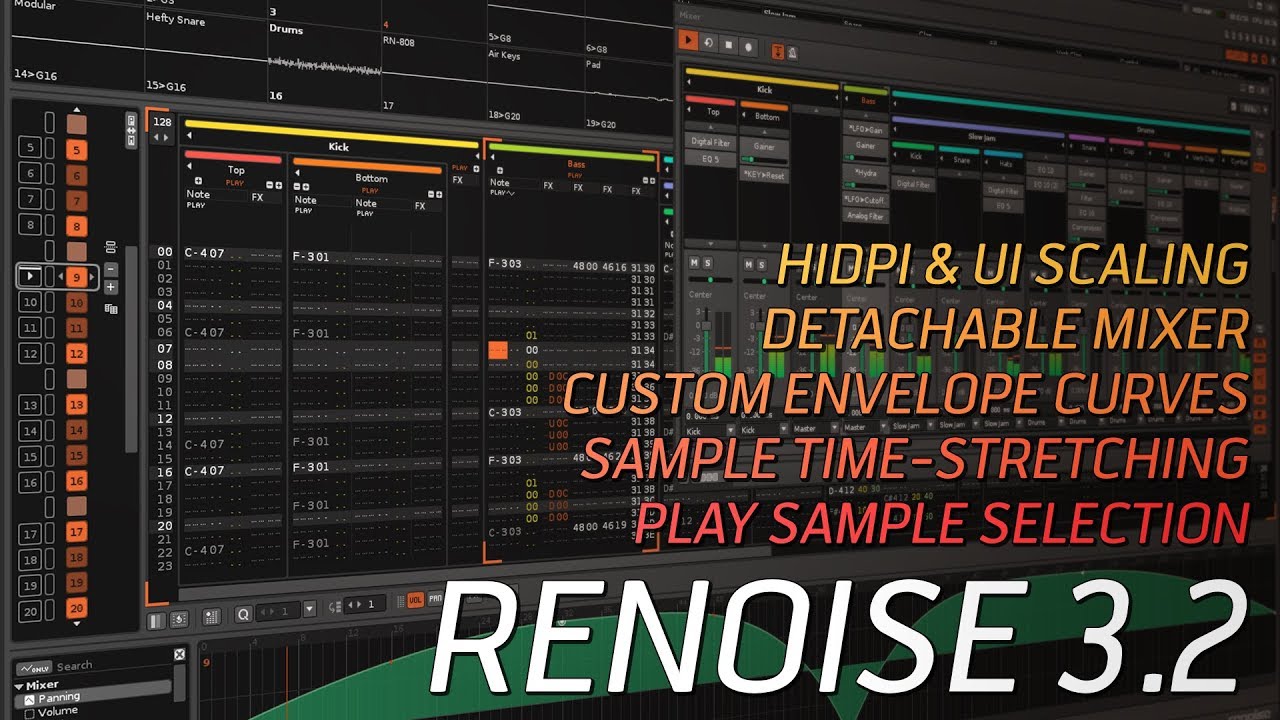Registered Renoise and Redux users can download the update, as usual, from the Renoise backstage.
Demo versions are available at Downloads | Renoise
What’s new
- HiDPI (Retina) support and custom GUI scaling options. See below for more information.
- Rubberband based native time-stretching options in the sampler.
- Detachable mixer view. (Renoise only)
- Custom exponential, per point scaling in all automation editors and the AHDSR modulation device.
- Preview of sample editor selections with computer keyboard or MIDI.
- A whole bunch of bug fixes.
- Lua API changes: see here Most Renoise 3.1 tools will auto-upgrade and work just fine in Renoise 3.2.
System requirements
Renoise
Renoise 3.2 is only available as a 64-bit application, but 32-bit plugins still can be loaded via the plugin bridge.
- Windows: Windows 7/8/10 64-bit or later. Windows 10 highly recommended when using a HiDPI monitor.
- Linux: x86_64 based Linux with glibc >= 2.19 (e.g. Ubuntu 14 or later).
- OSX: OSX 10.9 or later.
Redux
Redux is available as a 32 and 64-bit plugin.
- Any VST or AU (OSX) compatible 32 or 64-bit host.
- Windows: Windows 7/8/10 or later - 32 or 64-bit.
- Linux: x86 or x86_64 based Linux with glibc >= 2.19 (e.g. Ubuntu 14 or later).
- OSX: OSX 10.9 or later.
HiDPI & UI Scaling
HiDPI (High Dots Per Inch) or ‘Retina’ displays have a high resolution packed into a relatively small form factor, resulting in much greater pixel density than normal. Initially found on phones and tablets, they are becoming more commonly used in high-end laptops and monitors, especially those with a 4K resolution. Compared to regular displays, HiDPI renders pixels at twice the normal horizontal and vertical resolution, giving an overall density increase of 400%. To make use of this extra density without resorting to upscaling requires explicit support from the software application.
For more general and technical information about HiDPI:
Renoise is now HiDPI-enabled
Starting from version 3.2, Renoise is a HiDPI-enabled application. If you don’t have a HiDPI display this changes nothing, though you can still make use of the new ‘User interface scaling’ option. If your display is HiDPI then the OS will now draw the Renoise UI in the higher native resolution instead of manually upscaling. That upscaling is typically performed by the OS so that non-HiDPI-enabled applications appear at the same size as they would when running on a non-HiDPI display. The downside of upscaling in this manner is that the UI can become blurry and sometimes lacking in responsiveness - issues which Renoise can now avoid completely.
Disabling HiDPI Support
If you need to disable HiDPI support, this is performed in the following way depending on your OS:
- Windows: Right-click the Renoise executable and select ‘Properties’. Go to the Compatibility tab and click on ‘Change high DPI settings’. In the DPI settings dialog, enable the ‘Override high DPI scaling behavior’ option, then in the ‘Scaling performed by’ drop-down menu select ‘System’.
- OSX: Toggle the ‘Enable Retina support’ option in the Renoise “Preferences > GUI” tab.
Requirements for HiDPI Support
- Windows: Windows 10 is required for full support. On Windows 8 the Renoise UI will be HiDPI, but Plugin GUIs will not be scaled. Versions of Windows prior to 8 do not support HiDPI.
- OSX: No special requirements.
- Linux: If your current Linux setup works with a HiDPI display, Renoise should work too.
User Interface Scaling Option
Found in the “Preferences > GUI” tab, the new ‘User interface scaling’ option can override the amount of scaling used by the default ‘Auto’ setting, which uses your main display’s DPI value*, and instead uses a percentage chosen from 100-350%. This option can still be used to enlarge the Renoise GUI even if your display isn’t HiDPI, making it more comfortable to use on higher resolution screens.
* On Linux: When present, the X resource ‘Xft.dpi’ setting is checked and followed, then the scaling is deduced from the default display’s ‘DisplayHeight / DisplayHeightMM’ ratio.
Limitations
Currently in version 3.2, the entire Renoise UI can only be displayed at one single level of scaling. When using multiple monitors with different DPI settings (or a non-HiDPI display using a HiDPI setting), the UI will always be rendered at the DPI of the main display and then up/down-scaled as needed on the other display(s) by the OS. So, if your main display is HiDPI, but you want to use Renoise primarily on another non-HiDPI display, you should disable the HiDPI support in Renoise to prevent blurring and potential lag.
Using VST/AU Plugins on HiDPI Displays
Since plugin instruments and effects are actually external applications, their interfaces are not controlled by Renoise. Most old (and even many new) plugins don’t support HiDPI displays, which may have implications depending on your OS.
- Windows: By default all plugins are treated as non-HiDPI-compatible (because most plugins are not). So any plugin will be upscaled by the OS unless you tell Renoise that it supports HiDPI by unchecking “Plugin > Compatibility Options > Auto scale external editor”. This only applies to Windows 10. On versions prior to Windows 10, plugins that don’t support HiDPI will always appear small on HiDPI screens.
- OSX: When a plugin supports HiDPI and is running on such a display, it will just work in most cases.
- Linux: As far as we’re aware, there’s no way to automatically upscale non-HiDPI-compatible plugins. So if a plugin doesn’t support UI scaling it will appear small on HiDPI screens (the Renoise GUI will still scale properly).



